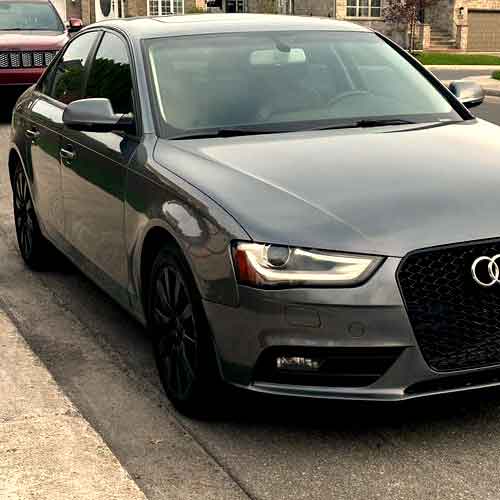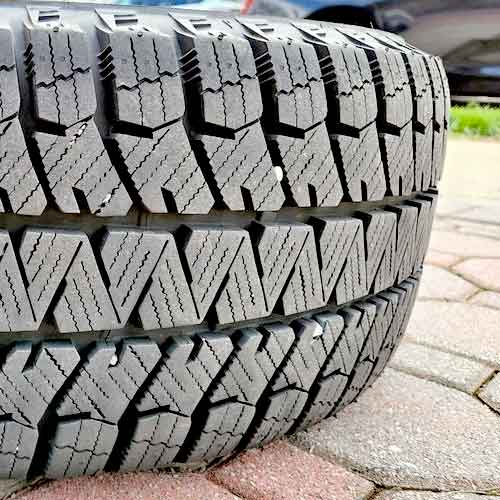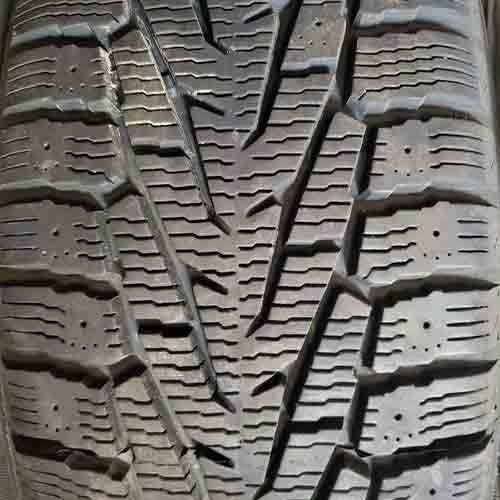Both the Bridgestone Blizzak WS90 and the Nokian Nordman 7 are renowned winter tires, lauded for their exceptional performance in adverse conditions. Let’s see which tire is a better pick for you?

Table of Contents
Tire Sizes
The Bridgestone Blizzak WS90 comes in 52 total sizes in 15 to 19 inches (wheels) with following specs.
- Speed ratings: T or H.
- Load ratings: SL or XL.
- Tread depth: 11 or 12/32″.
- Weight: 17 to 29 lbs.
- Tread warranty: None.
On the other side, the Nokian Nordman 7 (review) comes in 34 sizes in 13 to 17 inches rims, with following specs.
- Speed ratings: T only.
- Load ratings: SL and XL.
- Tread depth: 13/32″ on all.
- Weight: 15 to 27 lbs.
- Tread warranty: None.
Tread Appearance
The Bridgestone Blizzak Ws90 with its robust and intricate directional tread pattern, stands as a testament to superior tire design.

The tread is characterized by three distinct ribs, the central one running continuously.
This central rib is made up with a variety of wave-like sipes and features straight, interconnected slits, that are then, seamlessly integrated with in-groove notches.
Moreover, you also see V-shaped incisions/notches, as well, which are aimed towards both sides, augmenting the tire’s traction capabilities.
And in a similar manner, the shoulder lugs incorporate notches facing the central rib. Though they also have additional notches on the sides (aligned longitudinally).
Other than this, as these lugs have wide lateral grooves/voids in between, you get superior self cleaning capabilities with them.
And of course with the numerous sipes situated on them, you get excellent traction too.
On the other hand, Nokian Nordman 7 features a little more complicated design, yet, its also directional.

Let me start on this tire form the middle, as that is the most interesting area of discussion.
So here, you get two ribs, where the middle most is almost continuous running.
This rib basically looks like a vine having thick leaves. So all lugs feature thick in-groove notches to them.
And adding to their aggressiveness, all these lugs have biting edges to them, and yes, of course a ton of siping.
Same is the story of surrounding lugs, though they also carry sharp off set edges to them as well.
Moving towards shoulders, things are more streamlined here.
You see slanted lugs here, with a lot of tread features including multiple siping designs, off set edges and stud holes.
Wet Performance
When tires grip on wet surfaces, a lot depends on how many grooves/sipes, they have and how well the rubber on the tread can absorb water.
Now having said that, although both tires have plenty of grooves to move water away and help stop the tires from sliding on water (hydroplaning), you still get to see slightly better performance on Blizzak WS90.
This is because this tire has different kinds of sipes that are good at taking in and moving water, which helps it grip well when the road is wet.
Especially around corners, it does a great job because it has lots of closely packed sipes that are both tough and flexible.
On the other side, the Nokian Nordman 7 although is not too far off, it still falls a little short to its counterpart, with its less aggressive overall siping, and a stiffer rubber compound.
Snow Grip
In snowy conditions, the Nokian Nordman 7 has the upper hand, especially when it comes to driving in light, fluffy snow, (even though it’s not as good on ice or hard-packed snow).
So why is that?
Well, because of its tread pattern. It has a lot more in-groove notches and voids and these act as snow particle trappers, allowing for a better contact on the ground with the lodged snow.
And its better because snow sticks better to itself than it does to rubber.
On the other hand, the Blizzak WS90 takes a simpler approach, especially with heavy snow. Its tread pattern is not as spacious, or you can say, aggressive, so it isn’t able to provide as effective of the snow to snow contact.
Vibration Absorption
Tires serve as the first line of defense against road irregularities, effectively acting as auxiliary suspension systems for vehicles.
And in this department, with the innovative compound used in the Blizzak WS90, the tire takes away, a larger piece of the pie.
It’s tread compound basically handles uneven surfaces better, where its construction adeptly absorbs these disturbances, delivering a ride that is considerably smoother.
The Nordman 7 on the other hand, may carry a stiffer rubber, which is lacking here, it still does better in the second half of overall comfort, that is noise reduction abilities.
Noise Generation
Tire noise primarily originates from two ways;
- When air hits the walls, (which mostly enters the tread through shoulders voids).
- And when that noise echos around, within the tread, creating what’s called in-groove resonance.
Now, the thing is, Bridgestone Blizzak WS90 has closed up shoulder voids, so it does not allow a lot of air to come inside, in the first place.
But since its softer rubber produces larger in-groove resonance, you still get a comparatively louder tire here.
On the other hand, the Nokian Nordman 7 gets to be quieter with its superior pitch sequencing technology.
This technology basically alters the tread block geometry. So when air particles hit around, different tones get generated, which then try to cancel out each other.
Ice Traction
On icy surfaces, where you need a lot of tiny biters, you see a superior traction on Bridgestone Blizzak WS90, as the tire comes with angled cuts and V-shaped notches that point in different directions.
These biters combined with the tire’s more aggressive siping, you get quicker braking and handling efficacy.
And speaking of sipes, these are also multi-angled, allowing for a grip in all directions, improving traction further.
In contrast, the Nokian Nordman 7 struggles with its larger tread gaps and fewer notches.
Though still main reason of it lacking is its less aggressive siping pattern. They just don’t have as many, you can say, teeth to them, as seen on Blizzak.
So overall, Bridgestone WS90 is taking the lead on ice.
Dry Gripping
The effectiveness of directional grip is primarily hinged on the central tread area, as this is where the brunt of the tire’s load is focused during straight-line cruising.
And considering this factor, it can be explained why you get to see superior performance here, with Nokian tire.
Although both tires yield continuous central ribs ensuring persistent road contact, the Nordman 7 steps ahead with its more enclosed pattern extending to the surrounding lugs.
This leads to a noticeable reduction in braking distance by an average of 4 feet in tests, compared to the Blizzak WS90.
Dry Handling
The ability to handle, or the tire’s lateral grip, is contingent on the design of the shoulder lugs and the overall tread flexibility. Given this, it is understandable why both tires exhibit similar lateral g forces and lap times in testing scenarios.
Both tires for one, feature similar footprints form the shoulders, so they provide almost identical contact patch.
And they both feature similar steering response and a same kind of susceptibility to over and under steering.
Tread and Fuel Usage
The correlation between tread life and fuel economy is chiefly determined by rolling resistance, a factor largely influenced by the tire’s weight, tread composition, and design.
In terms of fuel, the Bridgestone Blizzak Ws90 comes out better with its more streamlined lugs, coupled with less aggressive tread voids, particularly in the middle.
These allow for a smoother, more continuous central rib. This design minimizes obstructions during straight-line rolling, thereby improving fuel economy.
In contrast, when it comes to tread life, the Nokian Nordman 7 takes the lead due to its harder tread compound and greater tread depth.
Essentially, tread life is influenced by two factors: the rate of rubber wear and the duration before reaching a critical wear level.
And benefiting from a lighter weight and a harder rubber compound, the Nordman 7 counters wear more effectively.
Its greater tread depth, in turn, means it takes a longer time to reach the legally mandated limit of 2/32″ of tread depth, thereby prolonging its lifespan.
To Sum Up
In this grueling comparison, both tires have demonstrated their mettle, each excelling in different arenas.
Blizzak WS90 outshines with its superior wet traction, vibration absorption, and ice performance, whereas Nordman 7 takes the lead in snow performance, noise generation, and dry gripping.
Interestingly, both tires show neck-to-neck competition in dry handling.
Furthermore, while Blizzak WS90 scores on fuel economy, Nordman 7 trumps on tread life.
Therefore, the ultimate choice will hinge upon individual requirements and the specific conditions that the driver encounters more frequently.